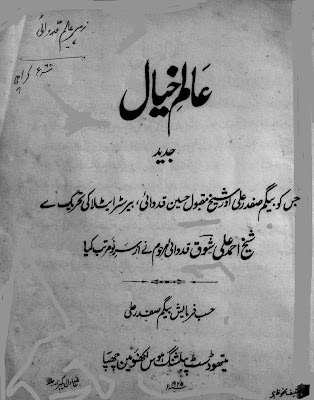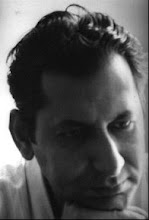Aalamé Khayaal
1968.
I was walking down Sadar near the Karachi Book Stall, a shop that was very popular for us when we were at school. It was very near where the tram used to stop when we wanted to save a bit of money.
Good money, believe me :)
The bus fare from Guru Mandir was an Anna (= 4 old Pice) to this place and the tram was 3 Pice from Soldier Bazaar. My house was halfway, so I could take either transport. You saved a whole Pice and after 4 days you had an Anna to buy a thanda paan (kept on ice!!!) at the Bohri Bazaar shop not far from here. That was Farzandaané Ali Kulfi Vaala! Very near the Umar Farooq Gate to a Bohri Bazaar Market.
Here's the first page from Huzoor Amma.
I was walking down Sadar near the Karachi Book Stall, a shop that was very popular for us when we were at school. It was very near where the tram used to stop when we wanted to save a bit of money.
Good money, believe me :)
The bus fare from Guru Mandir was an Anna (= 4 old Pice) to this place and the tram was 3 Pice from Soldier Bazaar. My house was halfway, so I could take either transport. You saved a whole Pice and after 4 days you had an Anna to buy a thanda paan (kept on ice!!!) at the Bohri Bazaar shop not far from here. That was Farzandaané Ali Kulfi Vaala! Very near the Umar Farooq Gate to a Bohri Bazaar Market.
It was a time when Shias and Sunnis could laugh off as friends and tease each other. I remember going to Bohri Bazaar once with Nasir Zaidi and Kavish Umar. Nasir said, "Yaar yeh tumhaaray Khalifa market mayñ kyooñ aa gaé?" ... and Kavish shot back, saying, "Bhai, jab Farzandaané Ali kulfi aor paan baich rahayñ hoñ to vo kyaa kartay!"
Although Karachi Book Stall was the place for new school books, it also sold a lot of used books of all sorts. I often went there to get SciFi and Philosophy books. Pity it no longer exists. But what good stuff from then exists now, anyway!
Just as I walked into the shop my eyes fell on this 'pamphlet-style' book lying right on top of some Urdu books. It was Aalamé Khayaal by Munshi Ahmad Ali Shaoq Kidvai.
Old and dilapidated cover …
… but the inside was clean.
I could see my grandmother's name
Begum Safdar Ali
(and Shaikh Maqbool Husain Kidwai's name.)
The inside back cover had an announcement
of Shaoq's last published work.
B U T …
… on the inside back-cover
was a stamp of my grandmother's name.
was a stamp of my grandmother's name.
It was her own book!!!
Huzoor Amma had died in 1936 and her books had been distributed to many cousins of Abi's who lived with her . It had found itself here, in Karachi Book Stall, sold by Mahjamal Phupi's children soon after her early death. They had no interest in such things, I suppose.
Mahjamal Phupi's father, Sarwar Ali Kidvai, had left for London in 1924 and lived on a house almost opposite Richmond Park. My father met with him when he was a student in UK and I visited him often. In 1971 Nuzhat & I went to see him and took a cassette-player and a tape of his favorite singer Ustaad Abdul Fayyaz Khan (transferred from my 78s) for him. He was thrilled. He said, "I always used to wake up and have Fayyaz's Bhaeraveeñ Thümri playing on my gramophone." He then took me to a corner and said, "Here are some of my books. None of my grandchildren read anything. Take this one that I want you to have — and anything else you want." I took 3 other books, too, but was totally in love with what he had decided to give me. The this he mentioned was Atiya Faizi's work, Sangit of India, given to him by her. I treasure it so much. It has enough anecdotes and stories to keep me reading bits again and again. A post on that will come soon.
But back to Aalamé Khayaal …
The pamphlet I was holding in my hand - thrilled as I really, really was - was not Aalamé Khayaal's first edition . This second edition did not have Huzoor Amma's picture (I have written about the first edition in my previous post). Printed in 1925, after she had insisted on a second edition, it was slightly revised and printed just two months after Shauq's death.
This marvelous book cost me 10 annas (65 new Paisa, in case you see this post many years after the word 'anna' has disappeared). That was lot of money in those days. The US $ had already become Rs.10, I think, but I do remember the $ being Rs 1-and-8-annas in my childhood.
Yes. That's how old I am …
… but I will be 24 (again) this year in October :)
The Foreword was by my dadi, as I mentioned in my earlier post. I am posting a couple of pictures from the book below.
Here's the first page from Huzoor Amma.
Here is another piece from her that talks of Western poets.
And, finally, here is a page from the book itself.
Enjoy!
•••••
For another great bookstall, visit this wonderful link
for a post by The Karachi Walla













